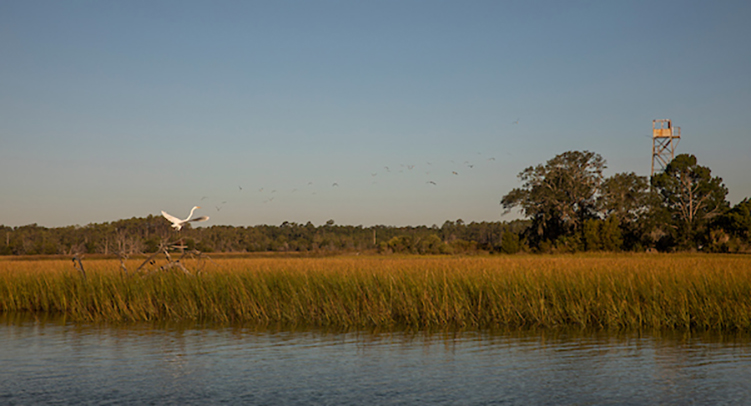
Jill Stewart is endlessly fascinated by the natural alchemy of the oft-maligned yet mighty microbe. These tiny living microorganisms are everywhere, from the surface of our skin and the air we breathe to the water we drink and the soil beneath our feet. In fact, microbes are essential to the persistence of life on Earth. So why do they sometimes get a bad rap?
“When you say microbes, people ultimately think of the pathogens that cause disease without appreciating the good bugs,” says Stewart, the new director of the University of South Carolina’s Baruch Institute for Marine and Coastal Sciences near Georgetown. “They are running everything … and we are here because of microbes.”
Stewart arrived at USC last August and is excited to begin her work at USC’s sprawling marine field lab. Already acquainted with the area, Stewart completed her dissertation research in Charleston years ago while working as a contract microbiologist with the National Oceanic and Atmospheric Administration.
“It’s beautiful here, of course, but I chose Baruch because of its long history of marine research and wonderful contributions to science. I have known its reputation for quite a while. I also have family living in Charleston and Pawleys Island,” she says. “My heart has lived on the South Carolina coast. This is like coming home.”
Lend her an ear, and Stewart is always happy to talk about microbes.
“It’s an exciting time to be a microbiologist,” she says. “I am really interested in coastal ocean environments and water quality.”
Troubled waters
Stewart’s current research is focused on microbes that have a direct impact on human health. Central to that is a science called “microbial source tracking,” which is the process of discovering how microbial contaminants get into the environment, primarily water.
Millions of diseases are caused by exposure to microbial contaminants found in recreational waters, so analysis of water is a logical starting point. As unpleasant as it sounds, the presence of fecal matter from septic systems and animal waste in water comprises the majority of identified contaminants.
“A lot of times, pathogens we encounter come from wastewater,” Stewart explains. “One of the unique challenges on the coast is that a lot of the coast relies on septic systems that aren’t tied to water treatment plants.”
Most contaminants found in coastal waters can be associated with nonpoint source pollution, or water runoff from nonporous urban surfaces like paved roads, sidewalks and parking lots. Extreme weather events, such as hurricanes, can have a huge impact on watersheds and environmental water quality.
“I have done modeling studies that show that right after a major rain event is when you have the most contaminants,” Stewart says. “This is modeling that goes back to my NOAA days. When you have more impervious cover, you get more human pathogens, fecal contaminants and wastewater released into the environment.”
I chose Baruch because of its long history of marine research and wonderful contributions to science. I have known its reputation for quite a while.
Using a long-proven membrane filtration technique, water samples in Stewart’s lab are placed in containers with filters that can physically skim pathogens out of the water. Cells caught in the filters then are incubated in agar plates where they can grow into colonies, where they are counted and the bacterial density of the water calculated.
“You can’t see the E. coli bacteria, but I can filter water and collect the microbes on a plate (i.e. petri dish) and see if the colonies grow,” Stewart explains. “Using selective media, the microbes will produce colonies of a particular color. That is how we see them. … And sequencing methods are advancing so quickly. We can sequence everything. It becomes a data-mining exercise.”
Microbes are able to multiply quickly and share their genes with other microbes, including antibiotic-resistance genes that can be shared with naturally occurring bacteria in the environment. This can turn theoretically good germs into bad ones and pose a serious public health threat because antibiotic-resistant infections may not be treatable and become life-threatening.
Rock 'em sock 'em microbes
Make no mistake. Not all microbes are “bad.” In fact, Stewart insists that, of the trillions of microbes living in and on the human body, most are harmless. “Good” microbes in the gut facilitate the body’s absorption of nutrients and even help the immune system fight disease. People commonly use probiotics to maintain a healthy balance of microorganisms in the gut and to aid digestion.
“Wouldn’t it be great some day to have probiotics for the environment?” Stewart says. “Microbes have saved us before in cases such as oil spill cleanups. There are a lot of areas for potential innovation.”
In pondering the future, Stewart likes to imagine the possibility of developing sensors capable of immediately detecting environmental pathogens without the time needed for lab processing. This could enable, say, a lifeguard to stick a sensor probe in the water to assess (in real time) its safety for swimming.
Stewart enjoys coming to work every day for several reasons. She is beguiled by the commitment of faculty and staff she has met at Baruch, and she is driven by a prevailing sense of mission.
“We need to preserve the environment for future generations,” she says. “Being able to contribute to that is the ultimate privilege for me.”